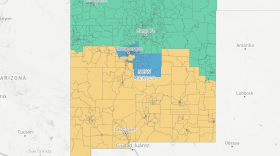As New Mexico redraws the district boundaries for its state legislature, U.S. House and Public Education Commission, pueblos across the state are collaborating on maps that reflect their peoples’ issues and needs. Tribal leaders are calling on the state’s redistricting committee to adopt the maps they put forward.
A new state law charges the Citizen Redistricting Committee with proposing several options of district maps to the state legislature.
At a recent hearing at the Indian Pueblo Cultural Center in Albuquerque to take public comment on creating the maps, tribal leaders called on the seven-member commission to seek-out their expertise and recognize their self-determination.
Acoma Governor, Brian Vallo, spoke on behalf of the All Pueblo Council of Governors, which represents the state’s 19 pueblos.
“We come before you to share the importance of incorporating into the 2021 redistricting efforts maps composed by and endorsed by the pueblos,” he told the committee.
Vallo warned the committee against treating tribal consultation as a formality. He said when he became governor in 2019, it had been nearly 30 years since he served as a tribal official, and it became clear that such engagement wasn’t always meaningful.
“I was taken aback by the fact that some of our federal and state agencies are still bringing us together and asking the same questions," he said. "And that our responses still were not being considered in the decision-making process.”
Vallo told the committee that the tribe stood their ground in the 2011 redistricting process.
“Unfortunately, it led to a lawsuit,” he said. “That should not have been necessary.”
In 2011, then-Governor Susana Martinez vetoed maps sent to her by the legislature. This led to several lawsuits, one of which came from pueblos arguing that maps that didn’t reflect population growth over the previous decade would fail to comply with the constitution’s Equal Protection Clause, the Voting Rights Act, and the doctrine of tribal self-determination. The state supreme court consolidated all of the redistricting suits and, as a result, the maps we have now were drawn up in state district court.
“Ten years ago our united efforts proved successful," Vallo said. "And we understand the power of our collective voice in the 2021 process.”
Attorney Casey Douma from Laguna Pueblo, co-chair of the All Pueblo Council of Governors’ redistricting committee, said when considering districts on tribal lands, it’s important to not just rely on where the reservations are located.
“When it comes to Native issues, borders and boundaries really don't mean much,” he said. “The issues at hand will transcend boundaries.”
Those issues include language, education, infrastructure and protecting sacred landscapes.
“Ten years ago when we looked at districts, on Mount Taylor there was an influx of interest in uranium mining,” Douma said. “And we saw maps being proposed that would isolate Mount Taylor away from a district that had the Laguna and Acoma. Pueblo leadership advocated very strongly that they wanted Mount Taylor in their district, because that mountain was sacred.”
As any community member can during this process, the All Pueblo Council of Governors plans to propose its own maps to the Citizen Redistricting Committee. Governor Martin Kowemy of Laguna Pueblo explained that the pueblo leaders would come to a consensus and should be afforded self-determination.
“Together, we examine different maps, review the data and discuss the pros and cons of those boundaries,” Kowemy said of the group’s vetting process. “We rely on the Voting Rights Act and the redistricting principles to guide our decisions so we support maps supported by law."
Gov. Kowemy went on to explain the power and influence of maps that accurately reflect tribal communities and values.
“The ability of Native Americans to elect representatives of their choice will impact our ability to develop economically, obtain sufficient education, protect critical cultural properties and protect our people and lands from the adverse economic development that threatens the health and safety of our climate," he said.
Legislative maps have the power to determine whether lawmakers are actually representative of their district’s people. 2020 Census data released last week shows that around 12.5% of New Mexicans identify, at least in part, as Native American. Democratic state Representative Georgene Louis grew up on the Pueblo of Acoma. She says those population numbers aren’t reflected at the Roundhouse.
“I am one of four Native Americans serving in the 70-member house,” Louis said. “The needs of our tribal governments often come to us, and that's great because we need to have seats at decision-making tables.”
The Citizen Redistricting Committee now begins the work of drawing and proposing several possible maps for each body. It remains unclear if it will include the All Pueblo Council of Governors’ maps among them.
*****
The public will have an opportunity to weigh-in on the draft maps in late September before a final set is sent to the legislature for consideration.
This public service is part of our #YourNMGov project, in collaboration with KUNM radio. Support for public media provided by the Thornburg Foundation.
Correction: This story has been corrected to reflect that the Citizen Redistricting Committee is a seven-member body and that Martin Kowemy is the governor of Laguna Pueblo.






